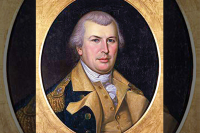Are the ‘possums adapting to headlight glare
 Where have all the opossums gone? People worry about cerulean warblers and frogs and honeybees and ash trees and hemlocks and snail darters and so on … as they should. But is anybody out there besides me worried about ‘possums? I doubt it.
Where have all the opossums gone? People worry about cerulean warblers and frogs and honeybees and ash trees and hemlocks and snail darters and so on … as they should. But is anybody out there besides me worried about ‘possums? I doubt it.
Maybe I shouldn’t be worried either. My “evidence” for their “decline” isn’t scientific. I’m not sure it’s even empirical … whatever that means. It’s just that I don’t see ‘possums lying dead in the highways anymore. In days gone by, there were times when the backcountry roads were littered with the critters. I exaggerate; nevertheless, I feel sure you know what I’m talking about. I even wrote a haiku-like bit of verse published in Permanent Camp last year that read:
‘possums have a fine sense of humor
even when lying in the road
Related Items
they find reason to grin
And in various’ possum essays written through the years, I’ve always managed to finish up with something like:
The only menace ‘possums have been unable to adapt to is the automobile. They are slain by the hundreds of thousands every year by onrushing vehicles during the nocturnal hours. Caught in the headlights’ glare they freeze and are thereby doomed. It’s too late to “play ‘possum,” which wouldn’t work anyway. But the automobile is a relatively new challenge. Let’s give these adaptive critters a little more time to form a response. They are, after all, the ultimate survivalists.
My acquaintance with ‘possums took place when I was a boy running a trap line in the early 1950s. This consisted of a series of wooden box traps and steel jump traps as well as various snares and deadfalls that I checked every morning before school. Even though they weren’t my prime quarry, it was ‘possums I wound up trapping about 90 percent of the time. I learned to show respect for their sharp teeth by getting them out of the box traps the right way: turn the trap up on its closed end; shake it; reach your arm through the open door; grab he or she by the long bare tail; drag he or she out with care; and hold it at arm’s length until you decide what’s next.
An article appeared in Smithsonian magazine in the 1970s titled “A Few Miles of Land Arose From the Sea – and the World Changed” by John F. Ross that I read with interest because it explained how the ‘possum got to North America in the first place. Ross’s primary interest was establishing the significance of the appearance of a land bridge (the Panamanian isthmus) between North and South America approximately three million years ago. Of the numerous critters that trekked northward over the isthmus, the lowly ‘possum has been the most successful because it became the most adaptable.
They may have small brains and be a touch dim-witted, but ‘possums can find food. And they can remember exactly where they found it in the first place, which – to my way of thinking – is the ultimate sign of intelligence. One researcher tested various animals for ability to remember which of four runways was connected to a food box. The ‘possum scored better on average than cats, chickens, dogs, goats, pigs, rabbits, rats, goldfish, and turtles, although somewhat less than the average crow. The parameters of its interests have been scientifically determined: (1) finding more food; and (2) reproducing more baby ‘possums.
Maybe there’s hope. Maybe they can figure out what the onrushing lights mean before it’s too late. Or maybe I’m wrong because I’m not getting out and driving the back roads enough. Or maybe the ‘possums got together and decided to move west into the Snowbirds or on into east Tennessee.
Whatever the reason I hope they make it.
George Ellison wrote the biographical introductions for the reissues of two Appalachian classics: Horace Kephart’s Our Southern Highlanders and James Mooney’s History, Myths, and Sacred Formulas of the Cherokees. In June 2005, a selection of his Back Then columns was published by The History Press in Charleston as Mountain Passages: Natural and Cultural History of Western North Carolina and the Great Smoky Mountains. Readers can contact him at P.O. Box 1262, Bryson City, N.C., 28713, or at This email address is being protected from spambots. You need JavaScript enabled to view it..









